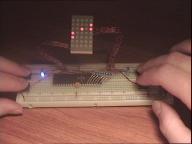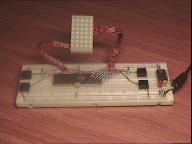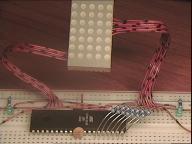


DivX video: pong.avi (768x576 25fps) (3.6 MiB)
The classic pong game. Two players. Press the buttons to move paddles up/down.
Ball bounces back and forth. If you fail to catch it, your opponent gets one point.
Score difference is showed with blue LEDs. Blue LED = lead by one point.
If you then win another point, you win the game, and your player number ("1" or "2") is displayed.
Bonus feature - Dual boot: When powering up, you have to press one of the two rightmost buttons.
One of them starts pong, and the other one starts ... that's right: The alphabet!
You can then scroll through the alphabet by pressing the buttons.
Exactly why this game of pong also contains an alphabet, is a mystery whose answer is lost in the mists of time.
Or something like that.
Made by
Håvard Moen (AVR know-how, programming, some construction),
Håkon A. Hjortland (construction, some programming) and
Alf Storm (font).
The LED dot matrix is driven with time multiplexing. The columns are displayed one by one in rapid succession, giving the illusion that they are all lit at the same time.
5x7.font
parse_font.c [syntax highlighting]
font.h [syntax highlighting]
pong_or_font.c [syntax highlighting]
Tiny Geurrilla Video Game Installation (MiniPong) - Very similar project
DivX video: projector.avi (768x576 25fps) (3.5 MiB)
Flicking artifacts are due to camera shutter. It looks good in real life. I promise!
A 16x16 20-30fps monochromatic(red) binary(no greyscales) digital video projector.
Made by
Håkon A. Hjortland (programming, construction),
Alf Storm (animation),
Håvard Moen (AVR know-how, construction help),
Ståle Kristoffersen (help with mirrors) and with some help from others.
Original idea (to use laser and rotating mirrors to create a video projector)
comes from an article in a science magazine (Illustrert Vitenskap) some time ago (no idea which issue).
Motor spins drum with 16 mirrors around at about 20-30 rev/second. The mirrors are tilted differently, so that they draw one line each on the screen. Rotation time is measured by the reading fork and divided by 16*32=512. This is the pixel clock. When the reading fork senses that the wire attached to the mirror drum passes, a new frame starts, and the pixel clock starts. For each pixel, the laser is turned on or off. Simple as that! Each line contains 32 pixels, but only 16 are used. The remaining 16 pixels on a line do either represent the gap between mirrors, or, they are used for calibration. Oh, yes. The calibration. I won't be attempting that again any day soon. Each mirror is calibrated in the Y-direction by tediously moving them physically. T-e-d-i-o-u-s-l-y. Did I mention that? The X-direction calibration is done with a lookup-table in software. Ahhh... software... :) And there's your picture. Making video is the easy part. That's just a matter of changing the picture every 4 or 5 frames or so.
projector.c [syntax highlighting]
video_alf.h [syntax highlighting]
test_pattern.h [syntax highlighting]
Questions? Drop me an e-mail at haakoh {a) ifi uio no.